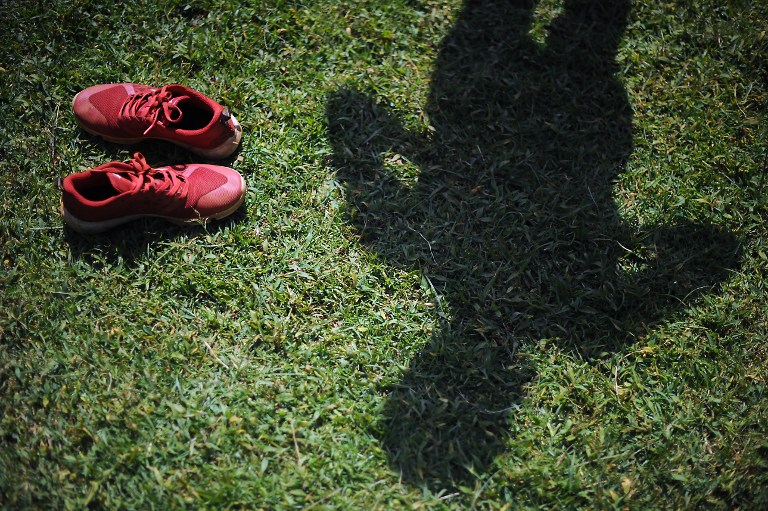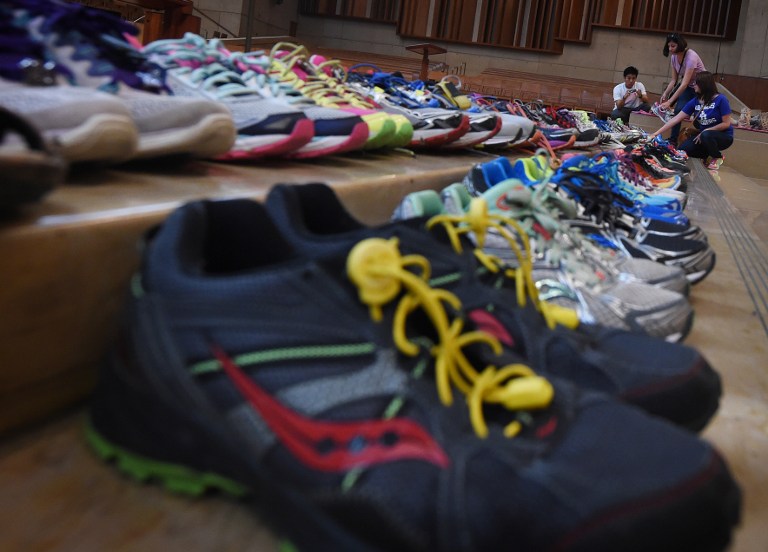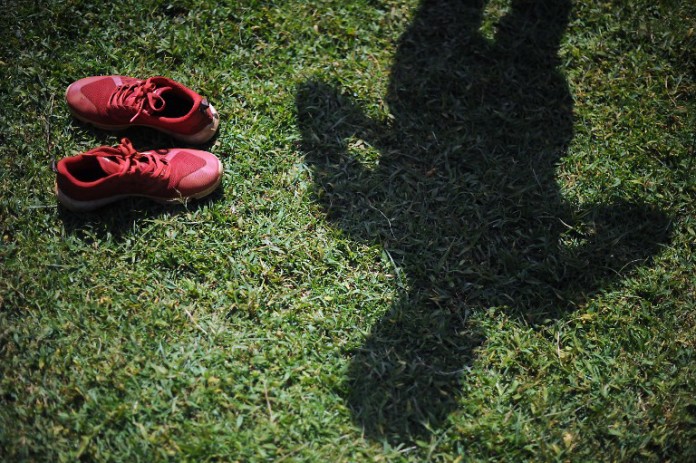SINGAPORE: Jeffrey Oon runs about 30km a week in his Nike Pegasus shoes – a “maximal” trainer with extra cushioning and thick soles, which the 42-year-old believes he needs after having previously suffered from plantar fasciitis, a condition which afflicts the heel and bottom of the foot.
Then there is Jordan Cave, a physiotherapist at the Core Concepts clinic and a self-confessed advocate of “minimalist” running – which attempts to simulate barefoot conditions through lightweight shoes with little to no padding. “I previously suffered from limiting knee pain that prevented me from running long distances, however since I changed to minimalist shoes and forefoot running (on the ball of the foot), my injuries have cleared completely,” he says.
Cave’s claim backs up a new study published on Monday (Nov 21) in the Medicine & Science in Sports & Exercise journal, which compared people running both forefoot and rearfoot (on the heel of the foot) in cushioned shoes with forefoot running in minimal shoes. The latter group was found to have slower loading rates, or speed of forces acting upon ground impact, thus suggesting a reduced injury risk.
Yet the contrasting experiences of Cave and Oon also reflect the mixed sentiments of other local runners and sports medicine experts on the findings of the study. Said Denis Mecklenburg, director of the PhysioActive clinic: “Running and injuries depend on so many factors. For instance, whether you run 5km once a week or 5 x 10km etc… It is much more complex than saying these shoes and this technique reduces the risk of injuries.”
MAXIMAL OR MINIMAL?
However Michelle Kwong, the principal physiotherapist at Physioclinic, said she agreed with the study when it comes to minimal shoes. “There is a popular belief that cushioning in shoes helps to reduce impact on our joints and tissues during weight-bearing activity. This is simply not true,” she declared. “If anything, wearing cushioned shoes means our joints and muscles are not able to properly absorb and distribute impact. This may lead to other problems higher up the body when you run a lot… There are other disadvantages with cushioned shoes, like muscle atrophy and needing to exert more force when running.”
Added Cave: “We have seen with research over the years a high prevalence of injuries in the tendon and quadricep muscle areas, as the cushioning and support within running shoes has increased.”
Kwong said: “Without cushioning, you’ll have a better feel of the impact going through your body, and your body will adjust and find the best way to land with the least amount of force. Usually, your body will then tend to adopt forefoot running automatically.”
Triathlete Liang Lemin concurred. “Running with minimalist shoes aids the runner to better understand how to run “light”, reducing the foot’s contact time with the ground and thus reducing the impact the leg has to absorb.”
But while minimal shoes may promote better running, podiatrists are also right in prescribing cushioned shoes, said the 29-year-old, who clocks up to 20km a week.
“We should be using as thick a pair of shoes that our body allows… with each step we take when running, our legs have to absorb a force that is many times our body weight,” Liang explained. “With a proper pair of cushioned shoes, the foam in the shoes is able to dissipate and reduce the force that bones, joints and muscles have to absorb.”
Kelvin Tay, principal podiatrist at The Sole Clinic, observed that the heavy emphasis placed by sports brands on marketing minimalist shoes has coincided with media coverage of athletes experiencing better performance in those shoes. “On the other hand, there have also been lawsuits successfully filed against footwear companies for making false and unsubstantiated claims about the health benefits of using minimalist shoes,” he warned.
Meanwhile Singapore marathoner Mok Ying Ren, a gold medallist at the 2013 Southeast Asian Games and orthopaedic surgeon himself, noted that minimalist shoes have been associated with increased injury risk in several studies.
“90 per cent of shoes fall in the moderate cushioning category. Minimalist shoes are very specialised and so are maximalist shoes,” he added, revealing that he uses shoes with moderate cushioning.

(Photo: Tony Karumba / AFP)
FOREFOOT OR REARFOOT?
The study’s espousal of forefoot running is also up for debate, said both Liang and Ray Loh, a senior physiologist at Tan Tock Seng Hospital’s Sports Medicine & Surgery Clinic.
“As much as running on the balls of your feet reduces traditional running injuries such as knee pain or shin splints, it does introduce new problems like achilles tendon or calf injuries,” said Liang.
Loh, a running coach and competitor in ultra-distances up to 250km, added: “Although forefoot running is able to eliminate the impact seen in a heel-striking pattern, the total impact forces dependent on our body weight and gravity cannot be eliminated. Changing the landing pattern merely transfers the impact force to other parts of the limbs.”
80 per cent of the running population are natural heel strikers, Tay noted.
Nonetheless, Kwong pointed to studies showing how forefoot running can improve arch height and general inner foot muscle strength.
“Minimalist and forefoot running allow us to run more efficiently by using the elastic recoil force of our calf muscles, and thereby avoid loading the anterior knee excessively,” Cave chimed in. “This is how humans were running prior to the invention of running shoes and sedentary lifestyles.”
Speaking to Channel NewsAsia, the study’s lead researcher Dr Hannah Rice said there was “a lack of direct or compelling evidence” relating to new injuries brought on by forefoot running.
She also argued it was “safe to draw conclusions” from the study despite its small sample size of 29. “We used statistical analyses which were appropriate for the data we had,” said Dr Rice. “What is important to remember is that we did not measure injury directly, and studies of huge sample sizes are required to understand injury directly.”

(Photo: Mark Ralston/AFP)
GRADUAL TRANSITION NEEDED
The real problem, said Mecklenburg, arises when people hear of such research and “think they can buy those shoes, change their technique and start running the same intensity as before – this is where lots and lots of people get injured”.
Injury risk is also influenced by how quickly runners switch to a different technique and shoe, said Dr Rice, who lectures biomechanics at the University of Exeter.
“Making a sudden transition to running in minimal shoes may increase the risk of injury, due to the unaccustomed nature of it. This is why we would recommend any transition to be gradual. It is also not easy to change foot strike, which is why we advise caution,” she said, a view shared by all the running experts interviewed.
Mok advised runners to choose shoes based on comfort. “If one is to try minimalist shoes, one should allow at least a month of adaptation by slowly increasing the volume of running in the shoe by 10 per cent each week, and to stop should there be any excessive discomfort and seek professional help,” he added.
Cave, meanwhile, said changing to a forefoot strike would necessitate giving time for calf muscles to adapt, as well as the building up of foot muscle strength. “It also takes time for the brain to change the way in which it activates muscle groups within the legs and feet to propel ourselves forward,” he noted.
Despite his overall endorsement of the study’s findings, Cave acknowledged that it was not applicable to everyone. “We all run in different ways, carry different injuries, run for different reasons, and are of varying body types,” he said.
“Before more definitive research is out on the best footwear and running style we should adopt, my speculation is that our running pattern is limited by our current strength and mobility,” said Loh.
Mecklenburg concluded: “From our experience with recreational runners, it is much more important to instruct proper running plans and strengthening exercises. This helps much more to avoid common injuries.”





